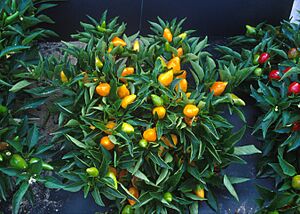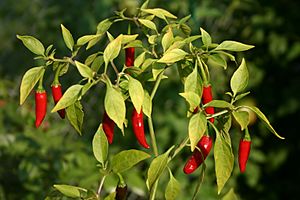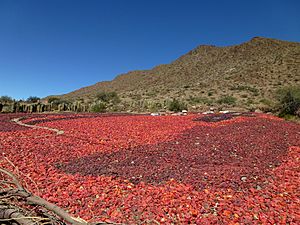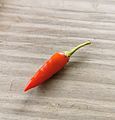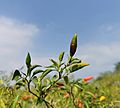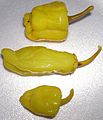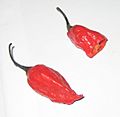Capsicum facts for kids
Quick facts for kids Capsicum |
|
|---|---|
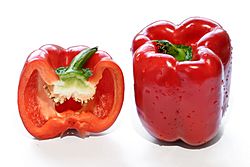 |
|
| Red Capsicum and cross section | |
| Scientific classification | |
| Kingdom: | |
| Division: | |
| Class: | |
| Subclass: | |
| Order: | |
| Family: | |
| Genus: |
Capsicum
|
| Species (selection) | |
|
|
Capsicum is a group of plants. They belong to the nightshade family. You might know them as Chili peppers, bell peppers, or just peppers! These plants are very useful. People use their fruits as spices to add flavor to food. They are also eaten as vegetables in meals. Sometimes, they are even used in medicine.
The names for these fruits can be a bit confusing. They change depending on where you are in the world. In places like Britain and the US, they are often called chili peppers. You might also hear them called red peppers or green peppers. The big, mild ones are usually called bell peppers in the US. In New Zealand English, Australian English, and Britain, they are often called capsicums. The word paprika can mean the fruit itself. It also means the powdered spice made from dried capsicum fruits.
Capsicum plants first came from the Americas. But today, you can find them growing all over the world!
Contents
Why Peppers Are Hot
Most Capsicum fruits have a special chemical. It is called capsaicin. This chemical gives peppers their famous burning feeling. You feel it in your mouth when you eat them! Most mammals, like humans, find this feeling unpleasant. But guess what? Birds do not feel the heat at all!
Plants developed capsaicin to protect their fruits. It stops mammals from eating them. At the same time, the bright colors of the fruits attract birds. When birds eat the fruits, they help spread the seeds. This helps new plants grow far and wide.
The amount of capsaicin in peppers can be very different. This is true even within the same type. This difference is because of their genetics. The only pepper that does not have any capsaicin is the bell pepper.
Chili peppers are very important in Native American medicine. Today, capsaicin is also used in Western medicine. It can help with blood circulation. It can also help to relieve pain.
Cooking with Peppers
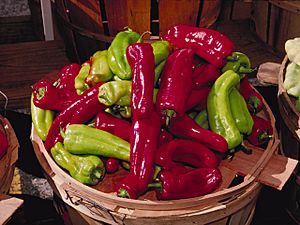
Capsicum fruits are super versatile in the kitchen! You can eat them raw or cooked. The kinds you usually find in cooking are types of C. annuum and C. pubescens. Other kinds are used too.
They are great for stuffing with yummy fillings. You can use cheese, meat, or rice. You can also chop them up and add them raw to salads. Or, cook them in stir-fries and other mixed dishes. People slice them into strips and fry them. They also roast them whole. Or, chop them into salsas and sauces.
Peppers can also be saved for later. You can do this by drying or pickling them. Dried peppers can be used whole. Or, they can be ground into flakes or powders. Pickled or marinated peppers are often added to sandwiches or salads. You can even make extracts from them to create hot sauces!
In 2005, a survey in Britain was done. It showed that peppers were the 4th most favorite vegetable!
Different Kinds of Peppers
There are many different kinds of Capsicum plants. They can be used in lots of ways. For example, the C. annuum species includes the "bell pepper." Bell peppers are sold when they are green. This means they are not fully ripe. They are also sold when ripe, turning red, yellow, or orange.
This same species also gives us other popular peppers. One is the Anaheim chili. It is often used for stuffing. The dried Ancho chili is used to make chili powder. Then there is the Jalapeño. It can be mild or quite hot. A smoked, ripe Jalapeño is called a Chipotle.
Most of the capsaicin, the hot stuff, is found in a pepper's white ribs. These are inside the fruit, where the seeds are attached. Special glands near the stem make the capsaicin. It then spreads from there.
The amount of heat in a pepper is measured. This is done using the Scoville heat units (SHU). This scale goes from 0 SHU for a mild bell pepper. It goes all the way up to super hot peppers like the Habanero.
Names for Peppers
The names for Capsicum fruits can be different. It depends on which English-speaking country you are in.
In Australia, New Zealand, India, Singapore, and Hong Kong, the peppers that are not hot are called "capsicums." The hot ones are called "chilli" or "chillies." The term "bell peppers" is not used very often there.
In the United Kingdom, Ireland, and Canada, the mild peppers are called "peppers." They are also called "sweet peppers" or "capsicums." The hot ones are called "chilli" or "chillies."
In the United States and Canada, the common mild peppers are called "bell peppers." They are also called "sweet peppers" or simply "peppers." The hot kinds are called "chile" or "chili peppers." Or, they are called by their specific names like banana pepper.
The name "pepper" came about because these plants have a similar hot taste. It is like black pepper. However, Capsicum plants are not related to black pepper plants. They are also not related to Sichuan pepper.
In Spanish-speaking countries, there are many different names. In Mexico, they use the word chile. In countries like Chile, Perú, and Argentina, they use ají. In Spain, mild peppers are called pimiento. Hot ones are called guindilla.
In Indian English, "capsicum" is only used for bell peppers. All other hot varieties are called chili. In northern India and Pakistan, bell pepper is also called "Shimla Mirch." This means "Shimla chili." Shimla is a hill-station in India.
In Polish, the word papryka is used. It means both the capsicum fruit and the dry spice.
In Hungarian, the word paprika is also used. It means both the fruit and the dry spice.
In Israel, capsicum is commonly called pilpel. This means pepper in Hebrew.
You can find out how hot a pepper is. Just check its score on the Scoville scale.
Medical Uses
Capsicum can be a good source of laxative. This is something that helps you go to the bathroom. It can also help relieve pain. Scientists have studied capsaicin. They want to see if it can help fight prostate cancer.
Images for kids
-
Capsicum annuum cultivars
-
Peperoncini (C. annuum)
-
Peperoncini in kebab restaurant
-
Cayenne pepper (C. annuum)
-
Habanero chili (C. chinense Jacquin)- plant with flower and fruit
-
Scotch bonnet (C. chinense) in a Caribbean market
-
Piri piri (C. frutescens 'African Devil')
-
Naga jolokia Chilli (bhut jolokia) (C. chinense x C. frutescens)
-
A small but very hot Capsicum in Malaysia
-
Peperoni cruschi, dried and crispy Capsicum from Basilicata
-
Capsicum in Bangladesh
-
Naga Morich in Bangladesh
See also
 In Spanish: Capsicum para niños
In Spanish: Capsicum para niños



